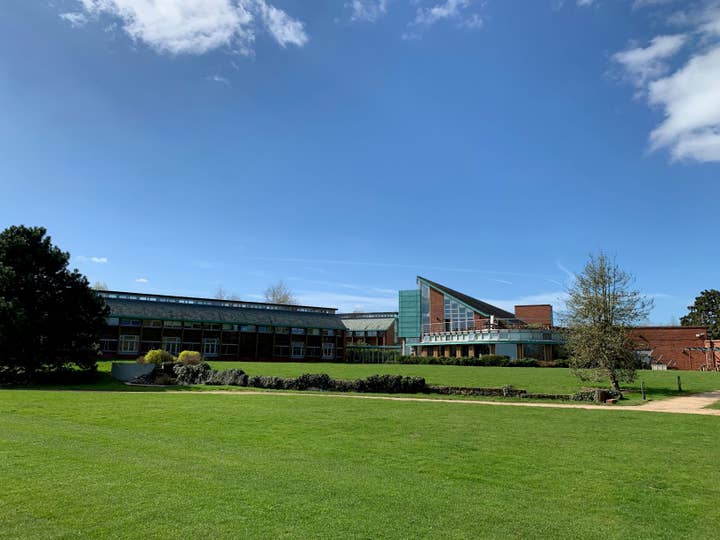Who saved Rare?
“We were so worried about challenging ourselves technically, that we paused a little bit with worrying about people”
Eight years ago, Eurogamer printed the article 'Who killed Rare?'
It was a sad read for fans of the studio. It came at a time when the company seemed to have lost touch with its audience as it focused on Kinect games. Fan sites were closing, with one long-running site openly criticising the company in a parting shot. Long-serving employees were moving on and it felt like Rare, which had achieved legendary status following a string of hits in the 1990s, had gone away.
"I never felt like we went away, but I can understand why we could have been perceived as that," says Louise O'Connor, who has spent 20 years at Rare and is now executive producer on its next game, Everwild.
"I don't know if we were having fun making things. The big thing about Rare is we have always challenged ourselves to do things that are really hard. I think we got to the point where we just weren't loving it the way that we could. It wasn't because we fell out of love with Rare, but perhaps we had fallen out of love with how we were approaching some of our development.
"I think we had stopped worrying about culture, actually. We were so worried about making a thing and challenging ourselves technically, that we paused a little bit with worrying about people and culture. Totally by accident. Then Craig [Duncan, Studio Head] came in, and the priority was about how do we change the culture? How do we make people fall in love with development again? It's a journey that you have to go on over a couple of years."
"I don't know if we were having fun making things back then"
Louise O'Connor, Rare
Studio head Craig Duncan jokes: "I am totally over [that article] now. A bit.
"It hurts to read stuff like that. I remember my message to the team was not to take any notice of people who don't know our studio. That was probably a bit defensive. Now, we are very overt with who we are and what we do... I don't think Rare had that then. We are in a different place.
"I felt back then I needed to defend ourselves, and say that Rare is definitely not dead and has plans for the future... by that's really just talk. We've actually gone and proven that now."
Eight years on, and the narrative around Rare has changed. Sea of Thieves has just passed ten million players, and enjoyed its most successful month since launch during December 2019. It has two teams working on projects for the first time in years, the studio size has expanded and the fans have come back -- there's even an unofficial Sea of Thieves festival this summer.
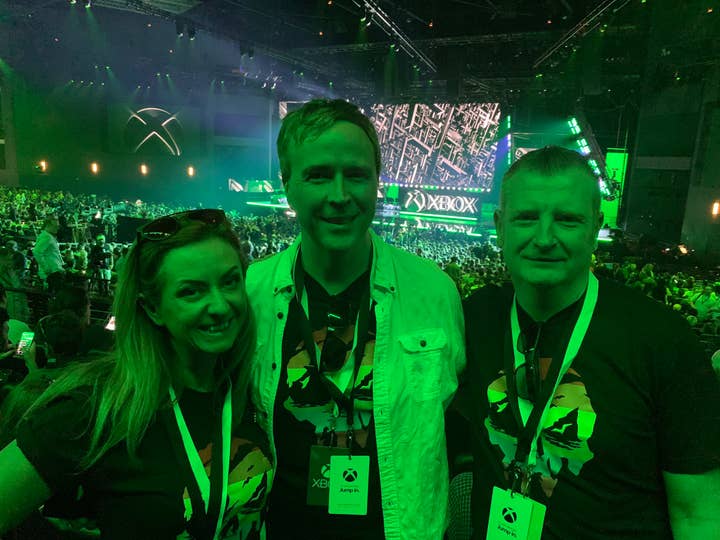
Rare may be enjoying a new golden period, but it's a different studio to the one that made a name for itself with Donkey Kong Country and GoldenEye. A lot of that is down to Sea of Thieves, which has seen the company open up to fans in a way the secretive Rare of old would never have.
"There was a time, probably ten years ago, where people knew Rare and its history, but they didn't know what it's about, or what it stood for, or who was there," Duncan acknowledges. "There was this veil of secrecy around it. Which was fine historically, but I'm not sure works in today's world.
"I don't think anyone in the industry can accuse us of not being genuine about what we're doing and why. But equally, we can still have a couple of secrets as well."
Director of Audience and Brand Strategy Simon Prodger says that the fans have largely come around: "Community attitudes have changed significantly over the last few years. As Sea of Thieves has become successful, the smaller Rare audience on social channels has certainly diminished in terms of their requirements over what they want to see next. They've bought into the vision of what Sea of Thieves is. People were very excited about Everwild. We didn't see any: 'Oh it's not Banjo 3'. It's a studio journey that the fanbase has been on as well."
This community focus has not just been in attending events and chatting to players on Twitter. Rare has thrown open its doors, invited fans to pitch ideas, and is even enabling them to create and sell their own merchandise.
"An interesting thing we've done is the stuff with Design By Humans," says head of brand and licensing Adam Park. "That's a site where we receive entirely fan-submitted Sea of Theives t-shirt designs. We get 100 to 200 submitted designs a week. It's not a revenue maker. Nearly all of the money made goes to the people who designed them. We think it's a great place for fans to effectively sell their own vision of Sea of Thieves."
"People were very excited when we announced Everwild. We didn't see any: 'Oh it's not Banjo 3'"
Simon Prodger, Rare
Duncan adds: "And then you get nice moments where if we do something on camera, and we happen to be wearing one, you get people going: 'Oh, Joe was wearing my t-shirt on the last video.'"
Sea of Thieves hasn't been entirely plain sailing. From the outset, Rare suffered server teething problems and ended up throwing out much of its post-release content strategy. The company then put out a series of major expansions, but that created internal challenges, and now it has switched to smaller, monthly updates.
"Working to get a lot of things together for a big update is hard," Duncan admits. "Building games is hard. We wanted to get into more of a rhythm with Sea of Thieves where we delivered frequently to our players, but also gave our team a more sustainable way of working. It removes some of the peaks and troughs.
"And while we will always try and be ahead of what we want to do, and adapt as things change, it's not the end of the world if we're trying to ship a feature in the January update and it doesn't quite make it, because then it just goes into the February one. Team sustainability and doing things that are right for that team, right for the culture and right for the players, is really important."
"We wanted to get into a rhythm with Sea of Thieves where we delivered frequently to our players, but also gave our team a more sustainable way of working"
Craig Duncan, Rare
Another difference between the Rare today and the Rare of yesteryear is how the teams work together. Back in the 1990s, Rare's various development teams were famously kept apart and encouraged to compete with one another. Duncan says that although the Everwild and Sea of Thieves teams are effectively studios in their own rights, they're still invested in each other's success.
"We made games very differently back then," says O'Connor. "I remember my time in the Conker barn. It was just the Conker team and we weren't really with anyone else. It meant I got very close with that team, and we still call each other the Conker team. But what's different now, is we know everybody. We can wander around all of the barns.
"We had this amazing all-hands meeting last Friday. That's when I really noticed how much Rare has changed. A couple of us did a little talk about what we're working on, and the support we got was incredible. It was genuinely caring. Joe [Neate, Sea of Thieves executive producer] is super excited about what we're doing with Everwild, and we are super excited about what they are doing.
"That's the biggest difference. Back in the day, it was quite competitive. We wanted to beat the rest. It's not like that anymore."
Duncan adds: "It's an easy trap to fall into, where 'that's their team, it's not our team'. It's hard to get it so that everybody is invested in everyone else's success. If you can get that right in a multi-game studio, you are onto something really special."
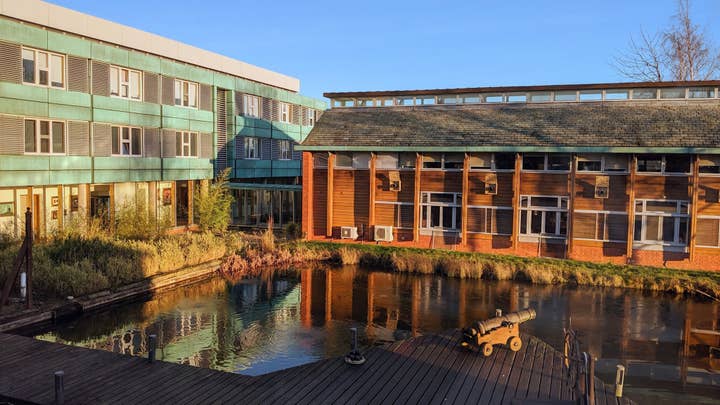
During our visit to Rare, Duncan was eager to show us the firm's new mantra on the wall of its boardroom. One that opens with: "Rare create the kind of games the world doesn't have".
All of the people we spoke to at Rare, either intentionally or accidentally, referred to the studio as being about 'new IP'. And to a certain generation of Rare fan, that will be disappointing to hear. To them, Rare is Joanna Dark, Banjo Kazooie and Conker.
And to these fans, Rare is meant to be secretive, and internally competitive. This company seems vastly different to the one Eurogamer was lamenting in its article. O'Connor even admits that it feels like she's been at multiple different studios during her 20-year stay.
Perhaps the Rare of old, in a way, has died.
"Doing new things have always been part of Rare's DNA," counters Prodger. "All we're doing is really formalising that."
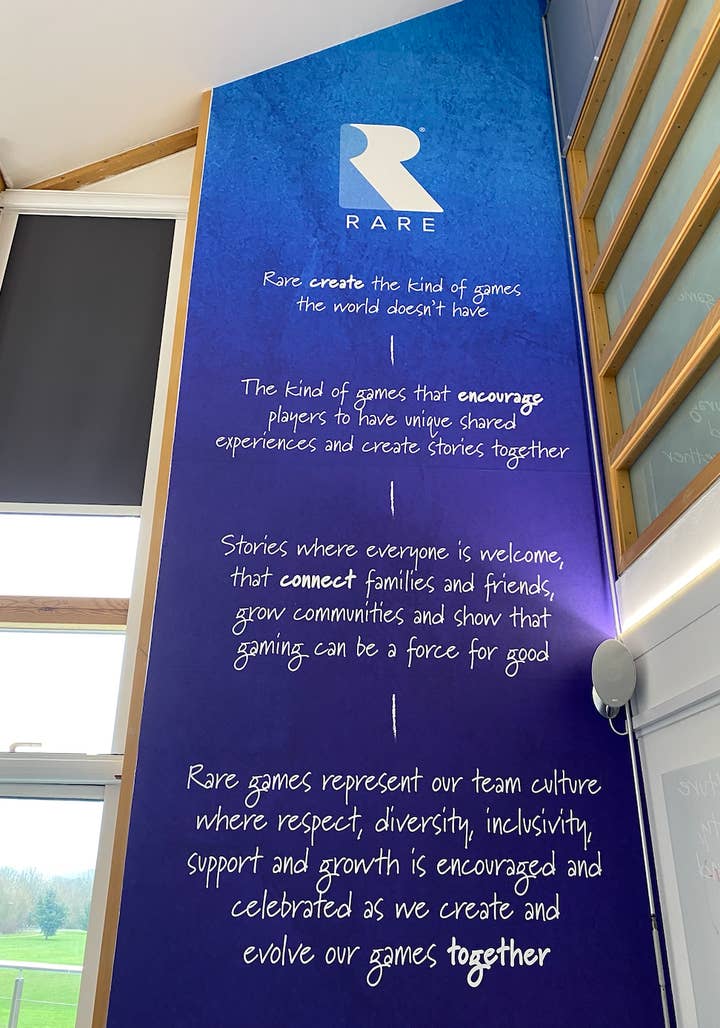
Duncan agrees: "Rare has redefined their future and redefined genres and done different things throughout their history. People who have been with the studio through all these different iterations know fundamentally what makes Rare what it is, and they've been part of this journey. Louise, Jim [Horth], Gregg [Mayles], Paul [Machacek]... they've been as much a part of the Rare transformation as those who are relatively new."
Many of those 'relatively new' people were also fans of the studio growing up, Duncan adds, so they also understand what the studio is all about. "We are lucky being a studio as old as we are, that we do have people join us as fans… but not just of what Rare used to do, but seeing what Rare is doing now and wanting to be a part of that," he says.
Meanwhile, when it comes to its classic brands, Rare insists it hasn't abandoned them. Which brings us onto a different part of Rare, the part that doesn't make games and doesn't get a whole lot of media attention. The part of the studio that worked with Nintendo in bringing Banjo and Kazooie into Super Smash Bros.
"Minecraft had paved the way for that relationship between Nintendo and Microsoft," Duncan recalls. "I met with Nintendo at the E3 before we announced it. And then we connected our teams, because we thought it seemed like a great opportunity.
"We had an initial kick off call with Sakurai-san and some of his team. There was myself, Gregg Mayles... who is the father of Banjo, even though he hates it when we call him that. Andrew Wensley, who runs our business team. And a chap called Paul Cunningham, who runs our partnerships. Those people had a conversation, [Nintendo] talked through what their approach would be, and then that process started.
"And then a year goes by of sharing animatics and ideas and character concepts. It was a back-and-forth. We ended up with something that was really great. But the execution came from the Smash team."
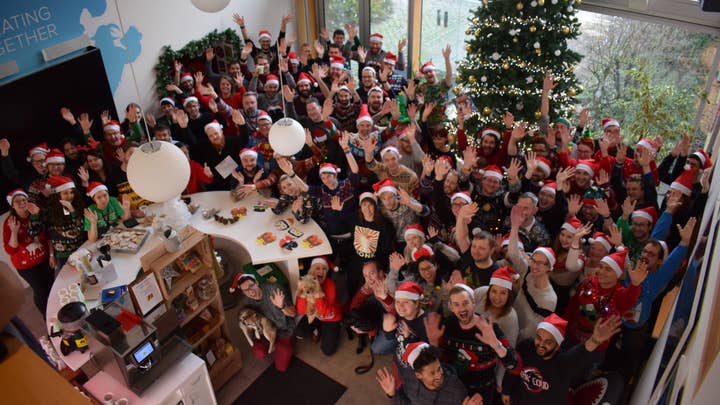
Rare has also struck an even more considerable partnership with indie studio Dlala on resurrecting its classic Battletoads IP. Duncan stresses that this is 'Dlala's game', but Rare is actively involved.
"They have their own art style and their own tone. It is their game, but we help and give feedback. It is more like a big brother developer helping another, rather than us having a publishing arm that's hired a developer."
Prodger says: "Our legacy is part of who we are. It is important for us to have that role in those processes. We have people that worked on Banjo, and even people who worked on the original Battletoads. We have that history and knowledge so that we think we can make those experiences better and more authentic. These brands are ours and we do care."
"If we said yes to everything that came across our table, we'd end up in a horrible place with our old IP"
Craig Duncan, Rare
Prodger refers to Battletoads as an 'interesting experiment', which begs the question, if this goes well, could we start seeing other Rare classics return via other indie studios?
Duncan pauses: "You've got to look at the right opportunity. If we said yes to everything that came across our table, we'd end up in a horrible place with our old IP. So we try to be selective.
"Battletoads was a Venn diagram of the right opportunity at the right time. We knew the team at Dlala pretty well. They've done work on some UI stuff for Sea of Thieves. They had a previous project that had some really interesting hand-drawn animation tech. [Dlala boss] Aj [Grand-Scrutton] is a big Battletoads fan. So you hit that perfect moment, where we had the right tech, the right team with a passion for the IP, and we had a trust relationship... so we thought there was an opportunity to try something.
"The process is then to assess it and work out if it fits with our strategy. It's easy to be busy on multiple things, but what is the real worthwhile thing to do?"
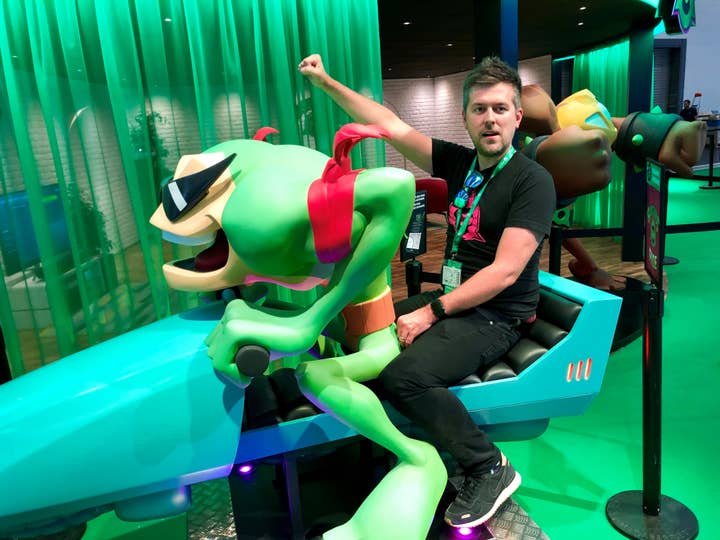
Rare's external partnerships are not just with studios. Around the launch of Sea of Thieves, the company launched an extensive licensing and merchandise plan, which it continues to operate (it's just released a Sea of Thieves tabletop RPG). This has extended to the company's legacy brands, too, with everything from high-end statues of Conker to Banjo cushions. And it's all something the studio handles internally.
"We don't make a tonne of money from [merchandise]," says Park. "We don't want people feeling taken advantage of. We don't have mobile phone covers and lanyards. We could have had all of that from day one, but we wanted everything to feel like it was from the world of the franchise they are from.
"If we were a centralised licensing group, I think we would end up, and a lot of companies do, with logo slaps on things. We see ourselves as the guardians of this, and we put as much care into this as we do our games."
"We see ourselves as the guardians of our brands, and we put as much care into [our licensing and merchandise business] as we do our games"
Adam Park, Rare
Duncan says Rare will grow its teams who handle things like merchandise and business arrangements, alongside the usual artists, designers and programmers. However, we shouldn't expect Rare to rival the big AAA studios in terms of size.
"We're now 200 people and we've been growing pretty consistently for five years, but we don't want to become this 500-person mega monolithic thing," Duncan says. "You erode culture when you do that. I think that's inevitable."
This is the real reason Rare wanted to invite us into the studio. Whereas we were keen to hear all about Sea of Thieves, Everwild and Battletoads, they wanted to talk about how they've changed the studio's culture. They wanted to tell us about their mental health team, their belief in inclusivity, their diversitiy initiatives, internal spirit champions, sustainability, special lunches, football nights, fitness groups, and so on. All of which has enabled the company to come together and give them the sense of freedom they need to make, as O'Connor puts it, "some really cool shit".
Because the team says it's been these changes, above any individual, game, business model or company, that has allowed Rare to turn its perception around.
"Honestly, in 20 years, this is the best, best, best time I have ever had in this studio." O'Connor concludes. "I don't think Sea of Thieves would have existed without the change in culture that we've brought in. It's just feeling believed in and trusted and confident to do something really brave. I don't think we've had that before.
"It has allowed us to be creative, and that is the biggest change for me. It is the most creative I've ever felt. And I'm a bloody producer."
